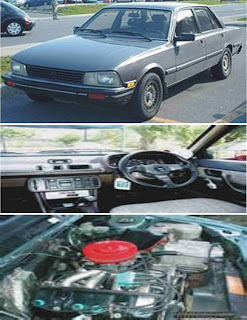
Clasification Peugeot 505
Manufacturer Peugeot
Parent company PSA
Also called Guangzhou-Peugeot GP 7202
Production 1979-1993 (Europe)
1981-1995 (Argentina)
1985-1997 (China)
Assembly Sochaux, France
Guangzhou, China
Los Andes, Chile
Villa Bosch, Argentina
Cairo, Egypt[1]
Predecessor Peugeot 504
Successor Peugeot 405
Peugeot 605
Peugeot 806 (Estate)
Class Large family car
Body style(s) 4-door saloon
5-door estate
Layout FR layout
Engine(s) 2.2L 120 hp (89 kW) I4
2.8L 145 hp (108 kW) V6
2.2L 150 hp (110 kW) I4
2.8L 145 hp (108 kW) V6
2.2L 180 hp (130 kW) I4
Transmission(s) 4-speed automatic ZF4HP22
5-speed manual BA-10/5
5-speed manual BA-7/5
Wheelbase 108 in (2,743 mm) (sedan)
114.2 in (2,901 mm) (wagon)
Length 181.4 in (4,608 mm) (1990-92 sedan)
194.5 in (4,940 mm) (1990-92 wagon)
198.9 in (5,052 mm) (Pre-1989 wagon)
186.7 in (4,742 mm) (Pre-1989 sedan)
Width 67.7 in (1,720 mm) (1990-92 sedan)
67.5 in (1,714 mm) (1990-92 wagon)
68.4 in (1,737 mm) (Pre-1989 wagon)
68.3 in (1,735 mm) (Pre-1989 sedan)
Height 57 in (1,448 mm) (1990-92 sedan)
60.1 in (1,527 mm) (1990-92 wagon)
60.6 in (1,539 mm) (Pre-1989 wagon)
56.7 in (1,440 mm) (Pre-1989 sedan)
55.6 in (1,412 mm) (Pre-1989 sedan)
Curb weight 1,210 to 1,380 kg (2,668 to 3,042 lb)
505 models varied very much in equipment. Base SRD cars with the 2304 cc diesel engine didn't even have power steering, but the GTD Turbo, the GTI, the V6 and the TI all had power steering, central locking doors, air conditioning, a 5-speed manual transmission, moonroof (except the GTD Turbo), and front fog lights. In the V6, the power steering was speed-sensitive, the central locking doors came with an infrared remote, and the heating and ventiliation systems included electronic climate control. A 3-speed automatic transmission was available on early 505s, which was later replaced by a 4-speed unit. The most durable 505 model proved to be the GTD with a 5-speed manual transmission. In Australia, the 505 was sold as a GR, SR, STi or GTi sedan, or an SR or GTi 8-seater station wagon, all with petrol engines. Very few GRD and SRD diesel engined 505s were sold in Australia. The Series II update saw the SR replaced with an SLi. The TI was not released in Australia, and the diesel models are rare.
The United States and Canada had their own 505 body. Notable differences were: gas tank moved inwards (now behind rear bench), with filling neck on rightside, different style quad headlamps, taillights (pre-1986 sedans), distinctive whip antenna moved from roof to rear fender (and changed to telescopic), larger bumpers, tailpipe moved from right to left. Fewer engines were offered, all detuned to meet more restrictive emission standards. The models sold in North America were: Base, "GL", "S", "GLS", "STI", "DL", "LIBERTE", "STX", "TURBO", "GLX", "SW8", "V6", "TURBO S", and in 1983 the "Anniversary Edition", which was sold in a limited quantity. All "North-American Bound" 505's were built in Peugeot's Sochaux Plant, in France.
A range of diesel and petrol engines were offered.
The diesel engines were all 4-cylinder:
2304 cc "XD2" engine (70 hp (49 kW)) from the Peugeot 504 was used on early models, and was supplied by Peugeot to Ford for their Sierra model.
2304 cc "XD2C" engine (70 hp (49 kW))
2304 cc "XD2S" turbocharged engine that produced 80 hp (60 kW)
2498 cc "XD3" engine that produced 75 hp (56 kW)
2498 cc "XD3T" turbocharged engine that produced 95 hp (70 kW) was used on 1985 (both XD2S and XD3T were available in the US in the 1985 model year) and newer models. Diesel engines no longer available in the US after 1986.
2498 cc "XD3TE" turbocharged diesel engine fitted with an intercooler, developing 110-115 hp (79 kW), was introduced in 1987.
The petrol engines had either 4 cylinders or 6 cylinders:
1796 cc 4-cylinder "XM7A" engine
1971 cc 4-cylinder "XN1/XN1A" pushrod engine had 96 hp (71 kW), then 100 (75 kW) by 1985 and finally 108 (79 kW) by 1991. Top speed: 175 km/h (109 mph).
1995 cc 4-cylinder ZEJK "Douvrin" engine (OHC, Bosch K-Jetronic fuel injection) had 110 hp (81 kW) - codeveloped by Peugeot and Renault.
2165 cc 4-cylinder ZDJK "Douvrin" engine (OHC, Bosch K-Jetronic fuel injection) used on pre-1986 models. This was a longer stroke version of the "ZEJK" engine.
2165 cc 4-cylinder ZDJL "Douvrin" engine (OHC, Bosch L-Jetronic fuel injection, Compression ratio: (9.8:1) ) with 130 hp (96 kW) was used on 505 GTI models. Top speed: 185 km/h (115 mph)
2155 cc turbocharged N9T "Simca Type 180" engine (OHC, Bosch LU-Jetronic fuel injection, Compression ratio: (7:1) ), producing 142 hp (106 kW).
2155 cc intercooled, turbocharged N9TE "Simca Type 180" engine (OHC, Bosch LU-Jetronic fuel injection, Compression ratio: (7.5:1) ), producing 150 hp (111 kW).
2155 cc intercooled, turbocharged N9TEA "Simca Type 180" engine (OHC, Bosch LU-Jetronic fuel injection, Compression ratio: (7.5:1) ), producing 160 hp (119 kW). 180 hp / 134 kW in 505 saloons. This motor was equipped with an electronic boost controller. Acceleration from 0 to 60 mph (96 km/h): 7.9 seconds.
2849cc 6-cylinder (V6) engine ("ZN3J", a version of the PRV engine) with 170 hp (125 kW) was used on 505 V6 models.








